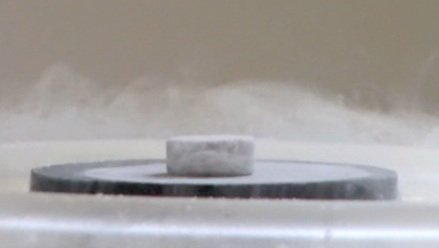 Meissner
Meissner
Explanation of the Meissner effect
Or: How to lift a magnet without touching it
Or: Numquam ponenda est pluralitas sine necessitate
In the right panel, a metal tube is placed on a magnet. The magnet's diameter is slightly smaller than the inner diameter of the tube, so the magnet can slide freely. The metal tube is rapidly lifted up by hand. The magnet is seen to move up together with the metal tube. Hence the magnet was lifted by the normal metal.
Why was the magnet lifted in the latter case? We can assume that the magnet never touches the inner wall of the tube. Nevertheless, as the tube is moved up, magnetic field lines from the magnet start to "cut through" the metal, and this generates eddy currents in the metal that create a magnetic field that interacts with the magnetic field of the magnet so as to oppose motion of the magnet relative to the metal tube. The basic physical principle is Faraday's law of induction.
Or in other words: the better conducting the metal is, the more it opposes magnetic field flux changes (Lenz's law). The magnetic field lines are essentially "frozen" in the metal and when the tube is rapidly moved up, the magnetic field lines stay initially where they are in the metal, hence the magnet moves up together with the metal tube. Because the metal is not a perfect conductor, it does allow magnetic field lines to move through it, albeit very slowly, as the magnet is pulled down by gravity, hence the magnet slides off the tube and starts falling.
This will only happen if the tube is metallic, because it needs to have mobile charges (electrons) to generate the eddy currents. The magnet would not be lifted if the tube was made of an insulating material.
So in the case of the magnet and the metal tube we understand the lifting of the magnet based solely on the laws of classical electromagnetism, Maxwell's equations, which include Faraday's law. Instead, according to the accepted theory of superconductivity since 1957, BCS theory, the lifting of the magnet in the case of the superconductor (Meissner effect) is not explained by the same physics. Quite the contrary, the same physics would predict that the magnetic field lines stay put, frozen, inside the superconductor (which is also a perfect conductor). Within BCS theory the lifting of the magnet is "explained" by postulating that the superconductor is described by a macroscopic wavefunction that does not admit magnetic field lines in its interior, without explaining the process by which magnetic field lines are expelled in apparent defiance of Faraday's law.
However, a well established law of the natural sciences, formulated by
Isaac Newton many years ago, states:
Numquam ponenda est pluralitas sine necessitate.
To the same natural effects we must, as far as possible, assign the same causes.
Can we assign the same causes to the same natural effect, lifting of the magnet, in the two different situations under discussion? Yes, as follows:
Assume that the metal going superconducting expels electrons from its interior to the surface as it becomes superconducting. We can think of the expelled electrons as part of a "metal" that is moving outward, carrying the magnetic field lines together with the moving charges, just as in the case of the metal tube discussed above, for the same cause, Faraday's law. That way, we have a common explanation for two phenomena that involve the same natural effect (lifting of a magnet), that are, within the conventional view, explained in very different ways when done by a normal metal and by a superconductor.
Of course it remains to be explained, why would electrons move outward when the metal becomes superconducting?
Well for this we need another reason. But it is not a reason cooked up specifically for superconductors, it's a basic law of physics: quantum pressure. Quantum particles want to expand their wavefunction in order to lower their kinetic energy. As the metal becomes superconducting it becomes more "quantum" than when it was normal, quantum pressure increases, electrons move outward to lower their kinetic energy, and if magnetic field lines were present inside the superconductor they are carried out by the moving charge, just like in the case of the moving metal tube, and the result is the Meissner effect.
To the same natural effects we must, as far as possible, assign the same
causes.
As to respiration in a man and in a beast,
the descent of stones [meteorites] in Europe and in America,
the light of our culinary fire and of the sun,
the reflection of light in the earth, and in the planets,
the lifting of a magnet by a normal metal and a superconductor.